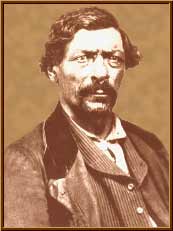Subject Guide

Mountain West
Malachite’s Big Hole

Beckwourth was born in Virginia in 1798. His father, Jennings Beckwith, was a white man; his mother was apparently Beckwith's African-American slave. The family moved to Missouri, perhaps for the relative tolerance that the frontier gave to the interracial liaison.
Beckwourth was apprenticed to a St. Louis blacksmith, a useful profession that may have brought him to the attention of General William Ashley. Ashley and Major Andrew Henry were partners seeking to exploit the fur wealth of the upper Missouri River country. Their company is associated with many of the legendary mountain men who emerged during this period. In 1822 the company advertised for adventurous men to explore the upper Missouri River and beyond in search of fur. The group recruited a veritable who's who of future mountain men: Jedediah Smith, Thomas Fitzpatrick, Etienne Provost, William Sublette, Jim Bridger, Hugh Glass. James Clyman and David Jackson are among those that joined the company in its first years. Jim Beckwourth was among these, perhaps starting his employment as a blacksmith.
Beckwourth may have played a role in the early exploration of Wyoming's South Pass and subsequent expeditions along the Bear, Weber, and Green rivers. What seems certain is that he was trapping in the Utah region by 1825, and he frequented the area over the next few years, often trapping in the Cache and Salt Lake valleys.
In that year of the first mountain man rendezvous at Henry's Fork (1825), Beckwourth began to establish his reputation as a master storyteller, telling heroic and improbable tales with himself at the center. Beckwourth also looked and dressed the part. Six feet tall and strongly built, he wore his dark hair to his waist and frequently sported braids, ribbons, earrings, gold chains, and Crow leggings.
The "facts" of Beckwourth's life are impressive enough. Simply to endure and survive in this unforgiving region implied that his hunting and survival skills were excellent. In 1828 he was captured and adopted by the Crow Indians (after another mountain man, in a tall tale told to Crow warriors, had described Beckwourth as a long lost Crow, stolen by a Cheyenne raiding party when he was just a child). Beckwourth willingly became a member of the tribe. He may have enjoyed the lack of racial prejudice among the Crow and may also have welcomed the relative sexual license that the lifestyle of the Indians permitted. Beckwourth became a "war chief" and participated in many battles, events that he gives great weight to in his life's account.
Beckwourth's adventurous spirit led him to participate in the Seminole War of 1837-38 in Florida. Returning to the West, he earned a substantial sum selling whiskey to the Cheyenne and operating saloons in New Mexico.
In the late 1830’s, he and other partners established what may have been the strangest trading establishment in the west know as El Pueblo (at the future site of Pueblo, Colorado). The crude adobe fort became “home” to a mélange of Americans, French coureurs de bois, Canadian Iroquois, Mexican trappers and traders, Negroes and European immigrants. Rent was free, and cheap Mexican whiskey was paid for in beaver. This post became something of a destination resort for mountain men who didn’t want to winter over in the high mountains, but also didn’t want the long journey to return to St. Louis or Taos.
In the 1840s Beckwourth crisscrossed California, as a gambler, prospector, guide (a famous pass is named for him), and horse thief. He served (perhaps unwillingly) as a guide for Colonel John Chivington at the notorious Sand Creek Massacre of the Cheyenne in 1864. In 1866 he returned to the Crow people and died near the Bighorn River.
There are there are several accounts of his death. The most accurate of these may be that recorded in a report related by James Thompson to Lt. George Templeton at Fort C.F.Smith in 1866. In 1866 there was trouble brewing between the Crow Indians and the whites. At this time Beckwourth was at Fort C.F Smith employed as a guide and interpreter. When the Crows learned that Beckwourth was at Fort C.F.Smith, they agreed to open communications, as long as Beckwourth would be the intermediary and that he would come back to their village. Beckwourth agreed, and Thompson accompanied Beckwourth. Beckwourth did succeed in his mission. Relations with the Crows were not only smoothed out, but the Crow agreed to help fight the Sioux Indians.
Apparently Beckwourth was sick when he left the fort, and was losing blood from his nose. On arriving at the Crow village he and Thompson were taken into the lodge of "Iron Bull" were both men remained. It was there that Beckwourth died. In death Beckwourth was treated as a Crow warrior, being "buried" on a platform in a tree by his host.
For more information regarding Jim Beckwourth see also:
The Life and Adventures of James P. Beckwourth, by Beckwourth, James P, published by Harper and Brothers, 1856. Many other editions.
Oswald, Delmont R: James P. Beckwourth, in The Mountain Men and the Fur Trade of the Far West, Volume VI; edited by LeRoy R Hafen, published by The Arthur H Clark Company, Glendale, California, 1966.
Back to the Top
Back to The Men